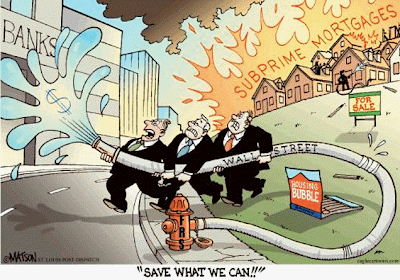In the following article, A Beautiful Scheme, Kevin Depew observes, "All of this is insanity, of course. And deep down we know it. Which is why one day, maybe as soon as 10 or 5 years from now, people will look back in astonishment and with wild-eyed wonder at the depraved charades we created." For those who read Phil’s Favorites, we’re hopefully presenting the insanity now, so that in 10 or 5 years, you’re not staring in wide-eyed wonder at whatever destruction lies ahead. – Ilene
Five Things: A Beautiful Scheme 
Courtesy of Kevin Depew at Minyanville
1. A Beautiful Scheme
Bad Real Estate Bets May Lead More Local Banks to Fail
– USA Today, April 9, 2009, "How Big Gambles Took Down Small Banks"
That’s the grim headline screaming across the top of the USA Today Money section. So far this year, 21 banks have failed, and the Federal Deposit Insurance Corp. is "keeping an eye on" at least 250 more "problem institutions" it believes are at risk of collapsing.
 Making the list of FDIC "problem institutions" is a bit like having your photograph quietly circulated among Atlantic City casinos for getting caught palming chips at the craps table. The FDIC, like casinos, demonstrably has a high tolerance for cheating, but this is key: it must be the right kind of cheating. Palming chips is a clumsy and embarrassing way to get banned from a casino, an act that reeks of reckless desperation. Which is why it’s so hated. No one likes a dishonest cheater.
Making the list of FDIC "problem institutions" is a bit like having your photograph quietly circulated among Atlantic City casinos for getting caught palming chips at the craps table. The FDIC, like casinos, demonstrably has a high tolerance for cheating, but this is key: it must be the right kind of cheating. Palming chips is a clumsy and embarrassing way to get banned from a casino, an act that reeks of reckless desperation. Which is why it’s so hated. No one likes a dishonest cheater.
And that brings us back to the FDIC. Earlier this week NY Times writer Andrew Sorkin reported that the FDIC is going to be insuring 85% of the debt – funneled through the Treasury – that "private" investors will use to acquire assets via the Public-Private Investment Program, or PPIP.
Although this is way beyond the scope and charter of the FDIC, certainly well above the provision that limits the FDIC to insuring no more than $30 billion, it’s okay, we’re told, because the FDIC can pretty much do whatever the hell it wants if the Treasury Secretary thinks it is necessary. Which he does.
If this sounds complex, don’t worry… It’s not. The nut of the thing is this: The FDIC, which was forced in March to raise fees to bolster its $15.7 billion bank insurance fund, and despite an increasing list of at-risk banks with deposits it will likely be forced to cover, is being used to "guarantee" loans to investors.
 Why? That also isn’t very complex. The FDIC has effectively been hijacked by Wall Street to protect banks, shoving the FDIC’s original mission — to protect depositors — a notch or 2 down the financial food chain.
Why? That also isn’t very complex. The FDIC has effectively been hijacked by Wall Street to protect banks, shoving the FDIC’s original mission — to protect depositors — a notch or 2 down the financial food chain.
Naturally, the FDIC "projects no losses" on these loans, as Sorkin reported in his original article. Because if they did, they wouldn’t be able to make them in the first place.
So what happens if, for some unexpected reason, the loans do show some losses? Good question. And if you think about it for a moment, you can begin to see precisely why the FDIC is being used in this way: Congress won’t authorize $1 trillion dollars in loan guarantees to finance the PPIP, because that would be a direct ripoff, and people would get upset. Seats would be lost.
But, if the FDIC guarantees the loans, and makes a mistake, well… We have to save the FDIC – they guarantee all our deposits.
It’s a beautiful scheme. Indeed, in the most perverse way imaginable, it’s the kind of scheme Americans can be proud of. 
2. What Is the FDIC?
According to its charter, it is this:
"The Federal Deposit Insurance Corporation (FDIC) is an independent agency created by the Congress that maintains the stability and public confidence in the nation’s financial system by insuring deposits, examining and supervising financial institutions, and managing receiverships."
3. … And Therein Lies the Problem
Nassim Taleb, author of Fooled by Randomness and The Black Swan, earlier this week penned a list of Ten Principles for a Black Swan-proof World for the Financial Times. The one I’m most interested in is number 7: "Only Ponzi schemes should depend on confidence." Unfortunately, that’s in direct opposition to the FDIC’s mission.
All of this is insanity, of course. And deep down we know it. Which is why one day, maybe as soon as 10 or 5 years from now, people will look back in astonishment and with wild-eyed wonder at the depraved charades we created – all for the express purpose of hiding from ourselves the magnitude of systemic looting we are engaged in. It’s not a callow conspiracy. It’s a viral infection of willful dumbness spawned by the Age of Self-Evidence.
4. This Is Not the Great Depression… It’s Worse
 Americans are nothing if not self-referential and narcissistic…. especially me, which is why I so frequently stoop to quoting myself, largely from long passages that were stolen from a salmagundi of bible-school pamphlets, true-crime detective magazines and truck stops.
Americans are nothing if not self-referential and narcissistic…. especially me, which is why I so frequently stoop to quoting myself, largely from long passages that were stolen from a salmagundi of bible-school pamphlets, true-crime detective magazines and truck stops.
And so I was fascinated to dig through this paper on a global comparative view of today versus the Great Depression, co-authored by Barry Eichengreen and Kevin H. O’Rourke.
5. Baseball’s Great Depression
But enough of all that worldly econo-speak. This is, after all, America… And it’s baseball season. When several friends noted the sparse attendance at the New York Mets game in Cincinnati last night, I sat down to see how baseball managed to squeak by in the last Depression, and came across this book review written back in 2002, which made some important socionomic observations about the game as played in the 1930s:
"Baseball was a tougher game in the 1930s – a tougher profession to follow and a tougher game to play on the field," said Alexander, distinguished professor emeritus of history at Ohio University. "It’s a great period in baseball history, for all the difficulties the sport had."
Those difficulties included sharp decreases in players’ salaries, the elimination of 32 player positions (two from each of the 16 teams) and the loss of 14 minor leagues – half of those in existence in 1930. Attendance waned at most ballparks: By 1933, major leagues were filling 40 percent to 45 percent fewer seats than in 1930. Team owners suffered a collective loss margin of 23.9 percent."
A collective loss of 23.9 percent? A similar loss in today’s far more leveraged professional sports environment would almost certainly mean the demise of more than one Major League Baseball franchise.


